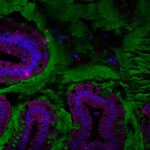Lien vers Pubmed [PMID] – 26185332
Lien DOI – 10.1152/ajpgi.00172.2015
Am J Physiol Gastrointest Liver Physiol 2015 Oct; 309(7): G528-41
Diet-induced obesity is often modeled by comparing mice fed high-fat diet (HFD), which is made from purified ingredients, vs. normal chow diet (NCD), which is a low-fat assemblage of relatively unrefined plant and animal products. The mechanism by which HFD promotes adiposity is complex but thought to involve low-grade inflammation and altered gut microbiota. The goal of this study was to investigate the extent to which HFD-induced adiposity is driven by fat content vs. other factors that differentiate HFD vs. NCD. Mice were fed NCD, HFD, or other compositionally defined diets (CDD), designed to mimic NCD and/or explore the role of HFD components. A range of metabolic parameters reflecting low-grade inflammation and adiposity were assayed. Relative to NCD, HFD, and to a lesser, but, nonetheless, significant extent, CDD induced increased adiposity, indicating both lipid content and other aspects of HFD are obesogenic. Moreover, HFD and CDD induced a rapid and marked loss of cecal and colonic mass. Such CDD-induced effects were not affected by adjusting dietary protein levels/types but could be largely eliminated by exchanging insoluble fiber (cellulose) for soluble fiber (inulin). Replacing cellulose with inulin in HFD also protected mice against decreased intestinal mass, hyperphagia, and increased adiposity. Such beneficial effects of inulin were microbiota dependent, correlated with elevated fecal short-chain fatty acid levels analyzed via (1)H-NMR-based metabolomics and were partially recapitulated by administration of short-chain fatty acid. HFD-induced obesity is strongly promoted by its lack of soluble fiber, which supports microbiota-mediated intestinal tissue homeostasis that prevents inflammation driving obesity and metabolic syndrome.


